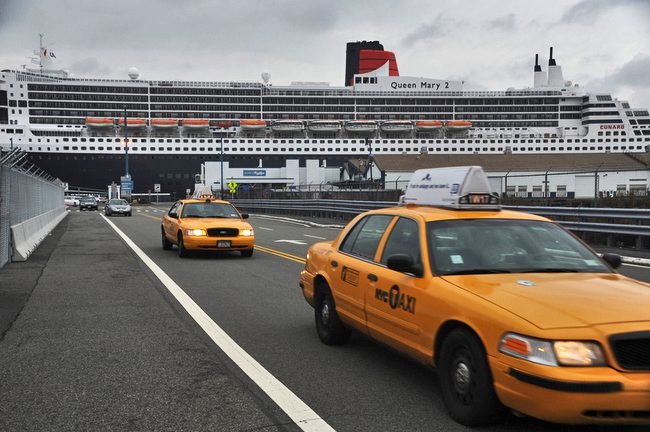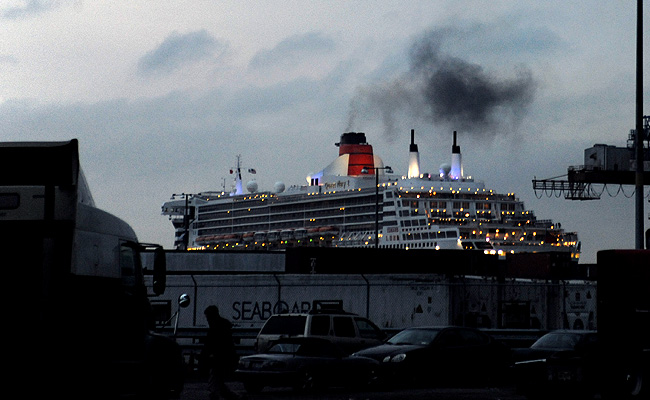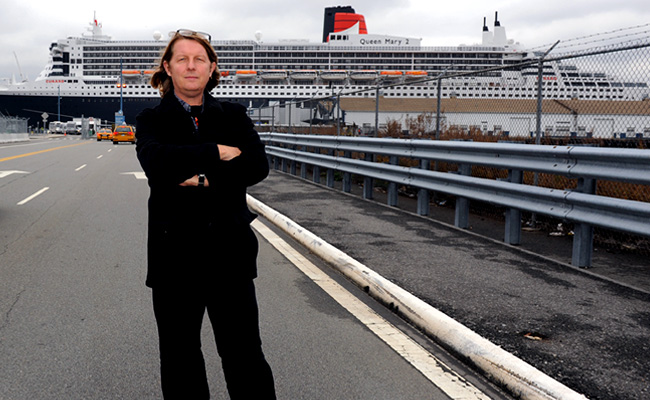
Billion dollar cruise corporation--Carnival--balks at $1 to $2 million bill to clean Brooklyn's air.
Photo by Joshua Kristal
One of America’s most profitable corporations—a luxury travel company that netted $6.1 billion in the last three years—is creating a major air pollution problem over South Brooklyn. City and state officials are continuing to drag their feet to fix it.
Back in November 2011, South Brooklyn Post was the first to report about large amounts of cancer-and-asthma-causing pollution released into the air when Carnival Corporation docks its luxury cruise liners at the Brooklyn Cruise Terminal, in Red Hook. The city built the cruise terminal for $52 million in 2006, and billed it as “state of the art.â€
While docked in Red Hook, Carnival’s cruise ships idle and burn the cheapest form of diesel available, called bunker fuel. While docked for a day, the ships release the equivalent air emissions of 12,400 cars over Red Hook, Carroll Gardens and the surrounding area, according to the EPA.
According to an October 2009 Port Authority report, the cruise ships docked in Brooklyn and Manhattan are the No. 1 cause of air pollutants over the New York Harbor, and the No. 2 cause of carbon dioxide emissions, with greater impact than truck traffic and cargo ship pollution.
Fast forward to October 2015: After years of delays, it appears that electrical equipment has been built along Red Hook’s shore in order for the cruise ships to plug in. Read all about it at local environmental blog A View From the Hook.
 Previously, a plan to fix the cruise ship pollution problem by building an electric shore power station for the ships to plug into while docked has stalled in backroom negotiations. Carnival Corp., the city and the state battled over who will pay $1 to $2 million a year in electric bills, according to interviews with city and state officials and documents from the New York Public Service Commission. The $1 to $2 million a year is the increased cost to Carnival for the ships to plug into electricity, as opposed to idling and burning bunker fuel.
Previously, a plan to fix the cruise ship pollution problem by building an electric shore power station for the ships to plug into while docked has stalled in backroom negotiations. Carnival Corp., the city and the state battled over who will pay $1 to $2 million a year in electric bills, according to interviews with city and state officials and documents from the New York Public Service Commission. The $1 to $2 million a year is the increased cost to Carnival for the ships to plug into electricity, as opposed to idling and burning bunker fuel.
A stalemate over the cost continues.
“The problem is to get all the parties to agree to the same thing at the same time,†said state Sen. Daniel Squadron, a Democrat who represents most of South Brooklyn.
It’s hard to see how $1 to $2 million would delay the deal. According to Global Financial News Wire, Carnival reported a net income, its profit after expenses are paid, of $2 billion for 2010, up from $1.8 billion in 2009.
According to a story earlier this month in The New York Times, Carnival pays one of the lowest corporate tax rates in the nation, at 1.1 percent of its $11.3 billion in annual profits paid in taxes to city, state, federal and foreign governments. Carnival is incorporated in Panama, Central America.
Media representatives for the company did not return calls for comment.
“Thanks to an obscure loophole in the tax code, Carnival can legally avoid most taxes,†reported the N.Y. Times’ David Leonhardt.

Adam Armstrong: Brooklyn’s Cruise Ship Pollution Fighter
Still, fuel costs have gone up in recent years, making bunker fuel attractive. It is not taxed by the state of New York. New York City Council is discussing whether to ask the state to repeal the tax exemption.
In the meantime, every five days, when a ship docks, the pollution continues.
New York’s cruise ship industry is booming—the city is now the third largest cruise ship market in the country. Red Hook’s terminal is home to Carnival’s $800 million Queen Mary 2, the largest cruise ship in the world, only 117 feet shorter than the 1,248-foot tall Empire State Building.
The city’s NYCruise website says the industry brings $1.13 billion to the city each year, with passengers spending $175 a day while docked here.
But air quality is suffering.
The Port Authority has designated the New York/New Jersey ports as having levels of ozone that “persistently exceed the national ambient air quality standards,†while the EPA has determined that much of the area “does not meet the national air quality standards for particulate matter… or ozone.â€
In August, the Port Authority of New York and New Jersey voted to spend $12.1 million to build the shore power station. The U.S. EPA granted another $2.85 million for the project. Carnival agreed to retrofit its ships and pay some of the electricity cost.
But the parties cannot come to agreement on the extra cost of the electricity, and who should pay.
International limits on sulfur and other emissions will come into play by 2012, and could force action.
Using shore power, called “cold-ironing,†is not new. The practice is used on the West Coast, in Alaska, in Europe and Asia. The U.S. Navy has used shore power for decades.
Local politicians held a press conference in January, in which they wore gas masks and demanded action on the power station.
The city continues to stay mum on the issue, not returning calls.
The issue is complicated, because of all the parties involved. The New York Power Authority (which generates electricity from Niagara Falls) would provide the electricity, and Con Ed would deliver it. The N.Y. Public Service Commission sets Con Ed’s electricity rates.
The Port Authority owns the land.
A Public Service Commission report in October lays out everyone’s stand in the battle. According to the document, the EPA and the city Economic Development Corporation want the Public Service Commission to set a special electricity rate for Carnival, so it can get cheaper electricity.
If Carnival did get a lower electricity rate, Con Ed’s other customers would have to subsidize the cost, and pay for it with higher bills, said James Denn, spokesman for the PSC.
Staff members of the PSC do not think that a special rate should be set for one company, according to the document, but the commission’s board has not publicly addressed the matter.
New York City Councilman Brad Lander, who represents Carroll Gardens and Red Hook and has lobbied for a deal, says an agreement must be made for the city or state to cover the cost for a couple of years.
After that, he says the Public Service Commission will have to lower the electricity rate to make shore power more attractive to Carnival.
“Everyone agrees the long-term answer is to get the Public Service Commission to set lower shore power rates,†Lander said.
He said he’s “guardedly optimistic†that an agreement is in the midst.
“I believe they are making progress. I’m optimistic we’ll get there without gas masks.â€
More on the cruise ship pollution in South Brooklyn Post
Politicians rally to force action
3/30/11
